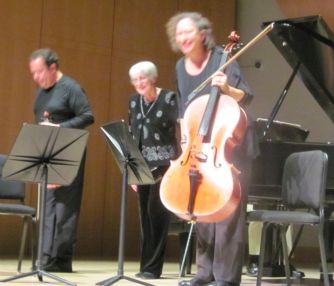|
Symphony
FROM THE NEW WORLD TO THE OLD WORLD
by Peter Lert
Saturday, June 14, 2025
Chamber
MC2 DUO RECITAL CLOSES 222'S SEASON
by Terry McNeill
Saturday, June 14, 2025
Choral and Vocal
CANTIAMO SONOMA'S LUSCIOUS A CAPELLA SINGING IN SEASON ENDING CONCERT
by Pamela Hicks Gailey
Sunday, June 8, 2025
Symphony
SRS SEASON ENDS WITH RESOUNDING TA-TA-TA-BANG
by Terry McNeill
Sunday, June 1, 2025
Symphony
YOUTHFUL VIRTUOSITY ON DISPLAY AT USO'S MAY CONCERTS
by Peter Lert
Saturday, May 17, 2025
Symphony
MYSTICAL PLANETS AND LIVELY GERSHWIN ORTIZ AT FINAL SRS CONCERT
by Peter Lert
Sunday, May 4, 2025
Symphony
VSO'S CONCERT MUSIC OF TIME, MUSIC OF PLACE
by Peter Lert
Sunday, April 27, 2025
VOCAL ELEGANCE AND FIRE AT THE 222'S RECITAL APRIL 26
by Pamela Hicks Gailey
Saturday, April 26, 2025
CANTIAMO SONOMA SINGS AN INSPIRED GOOD FRIDAY MOZART REQUIEM CONCERT
by Pamela Hicks Gailey
Friday, April 18, 2025
DRAMATIC SHOSTAKOVICH SYMPHONY CLOSES PHILHARMONIC'S 25TH SEASON
by Terry McNeill
Sunday, April 13, 2025
|
 |
 Trio Navarro Feb. 17: V. Romasevich, M. Thompson, J. Brindel |
UNEXPECTED ARENSKY AND MENDELSSOHN BY THE NAVARRO
by Terry McNeill
Sunday, February 17, 2019
The 100 people entering Schroeder Hall Feb. 17 for a Trio Navarro concert were handed a program that appeared to feature two popular piano trios, Mendelssohn and Arensky. But continuing the Navarro’s tradition of repertoire exploration, the pieces were not the usual first Mendelssohn and first Arensky, but the second from each composer, the C Minor (Op. 66) and F Minor (Op. 73), respectively.
But first came Haydn’s B-Flat Major Trio (Hob. XV:20), a short effervescent work that puts the lie to the contention that Haydn’s piano trios are accompanied solos. The opening allegro rustled along, bucolic and never demanding, contrasting pianist Marilyn Thompson’s long introduction to the andante with cellist Jill Rachuy Brindel and violinist Victor Romasevich playing variations. Mr. Romasevich played a lovely solo in the concluding finale.
The appetizer over, the Mendelssohn began with a wet, rich agitated string sound and a more leisurely tempo than expected with half-pedaled piano runs supporting a fine ensemble. The allegro energetico’s big false cadence before the end moved into a rush to the finish, an easy contrast to the lovely andante movement. Here Mr. Romasevich built many small climaxes in a romantic mix, all concluding with two shimmering pianissimo chords.
Mendelssohn writes scherzos like no other, and this five-minute movement was played in a pulsating rhythm with many repeated motifs and spiccato bow technique and humor. The Navarro again chose in the concluding allegro appassionato a tempo that was not racehorse, though surges of joy and vigor were everywhere, as was a hint of tragedy (but just a hint) in this virtuoso performance.
Following intermission I moved from the back of the hall to the second row, as piano legato is blurred way back in Schroeder, and much clearer up front with of course increased violin and cello volume. The more husky sound was welcome in the Arensky, a work from 1905 that has copious references to Chopin and especially Schumann. A quick tempo and meandering themes characterized the first movement, luxuriously harmonic but sharply different from contemporary Russians Tchaikovsky and Rubinstein, and the beguiling slow pace of the gold standard Borodin Trio’s recording from 1990. The accelerando at the end was explosive.
In the heart-on-sleeve romance the Navarro eschewed much rubati and kept the music from ever becoming cloying. A hard thing to do, given Ms. Brindel’s lovely ascending cello lines weaving about Mr. Romasevich’s elegant high register playing, and Ms. Thompson’s sensuous opening piano solo. The scherzo was dominated by both strings pizzicato that related to a waltz tune, with Ms. Thompson taking up rippling arpeggios in support.
Playing in the virtuosic closing variations (6) was at times in dance forms, nostalgic, and then busting out with fast scale playing and increased sonorities. Nothing was held back in this stirring performance where each variation had an individual character, with sprightly turns in the third and fifth. The Trio deftly played the surprising return of the first movement’s main theme with a subtle and slight change, making the composition’s quiet close all the more effective.
|

